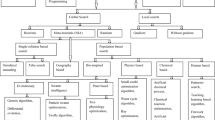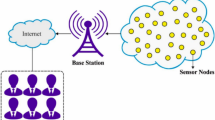Abstract
Wireless Chemical Sensor Network (WSCN) is one of the significant research areas in terrestrial networking due to their versatility. Expanding the overall runtime without adding additional batteries or hardware is one of the most challenging tasks. To overcome this challenge a novel Pareto Multi-objective Termite Colony Optimization-based EDT (Energy, Distance, Time) clustering technique, has been proposed in this research. Initially, Pareto multi-objective optimization strategy is used in the termite colony optimization technique to address WCSN routing's resource constraints and security concerns. In addition, a function called Substitute Cluster Head (SCH) is utilized, which replaces the current Cluster Head and the rotating system was proposed to reduce the energy loss during the CH rotation. Improving energy reliability and network lifetime are the main aspects of this research. The effectiveness of the proposed strategy is examined using the parameters, such as lifetime of the network, energy consumption, load balancing, and Throughput. The existing technique attains the network lifetime of 12.4% of LEACH, 15.4% of Genetic Algorithm, and 23.37% of EE-LEACH, but our suggested PMTCO-based EDT Clustering extends network lifetime by 41.2% and decreases energy usage by 7% when determining the SCH.










Similar content being viewed by others
Data Availability
Enquiries about data availability should be directed to the authors
References
Kassal, P., Steinberg, M. D., & Steinberg, I. M. (2018). Wireless chemical sensors and biosensors: a review. Sensors and Actuators B: Chemical, 266, 228–245.
Shahraki, A., Taherkordi, A., Haugen, Ø., & Eliassen, F. (2020). Clustering objectives in wireless sensor networks: A survey and research direction analysis. Computer Networks, 180, 107376.
Alghamdi, T. A. (2020). Energy efficient protocol in wireless sensor network: Optimized cluster head selection model. Telecommunication Systems, 74(3), 331–345.
Singh, H., & Singh, D. (2021). Hierarchical clustering and routing protocol to ensure scalability and reliability in large-scale wireless sensor networks. The Journal of Supercomputing, 77(9), 10165–10183.
Moussa, N., Alaoui, E. B. E., & A. (2021). An energy-efficient cluster-based routing protocol using unequal clustering and improved ACO techniques for WSNs. Peer-to-Peer Networking and Applications, 14(3), 1334–1347.
Verma, S., Sood, N., & Sharma, A. K. (2019). A novelistic approach for energy efficient routing using single and multiple data sinks in heterogeneous wireless sensor network. Peer-to-Peer Networking and Applications, 12(5), 1110–1136.
Gupta, G. P., & Jha, S. (2018). Integrated clustering and routing protocol for wireless sensor networks using Cuckoo and Harmony Search based metaheuristic techniques. Engineering Applications of Artificial Intelligence, 68, 101–109.
Khabiri, M., & Ghaffari, A. (2018). Energy-aware clustering-based routing in wireless sensor networks using cuckoo optimization algorithm. Wireless Personal Communications, 98(3), 2473–2495.
Chen, L., Liu, W., Gong, D. and Chen, Y., 2020, June. Clustering and routing optimization algorithm for heterogeneous wireless sensor networks. In 2020 International Wireless Communications and Mobile Computing (IWCMC) (pp. 407–411). IEEE.
Lata, S., Mehfuz, S., Urooj, S., & Alrowais, F. (2020). Fuzzy clustering algorithm for enhancing reliability and network lifetime of wireless sensor networks. IEEE Access, 8, 66013–66024.
Wang, Z., Ding, H., Li, B., Bao, L., & Yang, Z. (2020). An energy efficient routing protocol based on improved artificial bee colony algorithm for wireless sensor networks. IEEE Access, 8, 133577–133596.
Sah, D. K., & Amgoth, T. (2020). A novel efficient clustering protocol for energy harvesting in wireless sensor networks. Wireless Networks, 26(6), 4723–4737.
Puneeth, D., & Kulkarni, M. (2020). Data aggregation using compressive sensing for energy efficient routing strategy. Procedia Computer Science, 171, 2242–2251.
Mehta, D., & Saxena, S. (2020). MCH-EOR: Multi-objective cluster head based energy-aware optimized routing algorithm in wireless sensor networks. Sustainable Computing: Informatics and Systems, 28, 100406.
Dehghani, S., Barekatain, B., & Pourzaferani, M. (2018). An enhanced energy-aware cluster-based routing algorithm in wireless sensor networks. Wireless Personal Communications, 98(1), 1605–1635.
Asha, G. R. (2018). Energy efficient clustering and routing in a wireless sensor network. Procedia computer science, 134, 178–185.
Darabkh, K. A., Al-Maaitah, N. J., Jafar, I. F., & Ala’F, K.,. (2018). EA-CRP: A novel energy-aware clustering and routing protocol in wireless sensor networks. Computers & Electrical Engineering, 72, 702–718.
Zachariah, U. E., & Kuppusamy, L. (2022). A hybrid approach to energy efficient clustering and routing in wireless sensor networks. Evolutionary Intelligence, 15(1), 593–605.
Maheshwari, P., Sharma, A. K., & Verma, K. (2021). Energy efficient cluster-based routing protocol for WSN using butterfly optimization algorithm and ant colony optimization. Ad Hoc Networks, 110, 102317.
Dwivedi, A. K., & Sharma, A. K. (2021). EE-LEACH: Energy enhancement in LEACH using fuzzy logic for homogeneous WSN. Wireless Personal Communications, 120(4), 3035–3055.
Lee, W., Yonghee, J., Hyunseung, J., Chulhun, S., Hosung, C., & Hojin, L. (2019). Wireless-Powered Chemical Sensor by 2.4 GHz Wi-Fi Energy-Harvesting Metamaterial. Micromachines, 10(1), 12.
Wang, Q., Lin, D., Yang, P., & Zhang, Z. (2019). An energy-efficient compressive sensing-based clustering routing protocol for WSNs. IEEE Sensors Journal, 19(10), 3950–3960. https://doi.org/10.1109/JSEN.2019.2893912
Wang, T., Zhang, G., Yang, X., & Vajdi, A. (2018). Genetic algorithm for energy-efficient clustering and routing in wireless sensor networks. Journal of Systems and Software, 146, 196–214.
Pachlor, R., & Shrimankar, D. (2018). LAR-CH: A cluster-head rotation approach for sensor networks. IEEE Sensors Journal, 18(23), 9821–9828.
Lalwani, P., Das, S., Banka, H., & Kumar, C. (2018). CRHS: Clustering and routing in wireless sensor networks using harmony search algorithm. Neural Computing and Applications, 30(2), 639–659.
Funding
The authors received no specific funding for this study.
Author information
Authors and Affiliations
Corresponding author
Ethics declarations
Conflict of interest
The authors declare that they have no conflicts of interest to report regarding the present study.
Additional information
Publisher's Note
Springer Nature remains neutral with regard to jurisdictional claims in published maps and institutional affiliations.
Rights and permissions
Springer Nature or its licensor (e.g. a society or other partner) holds exclusive rights to this article under a publishing agreement with the author(s) or other rightsholder(s); author self-archiving of the accepted manuscript version of this article is solely governed by the terms of such publishing agreement and applicable law.
About this article
Cite this article
Joseph, A.J., Asaletha, R. Pareto Multi-objective Termite Colony Optimization Based EDT Clustering for Wireless Chemical Sensor Network. Wireless Pers Commun 130, 2329–2343 (2023). https://doi.org/10.1007/s11277-023-10245-2
Accepted:
Published:
Issue Date:
DOI: https://doi.org/10.1007/s11277-023-10245-2




